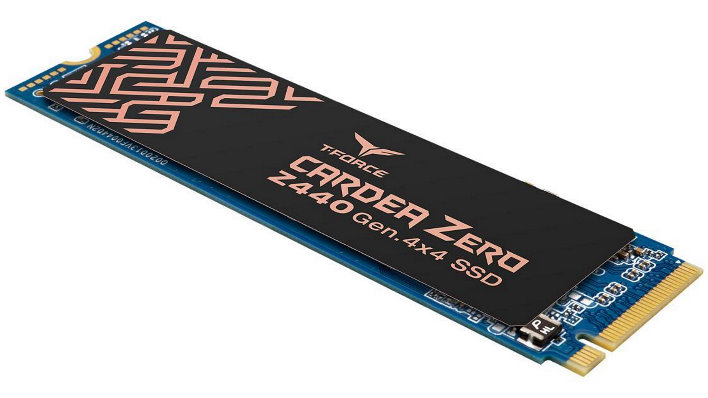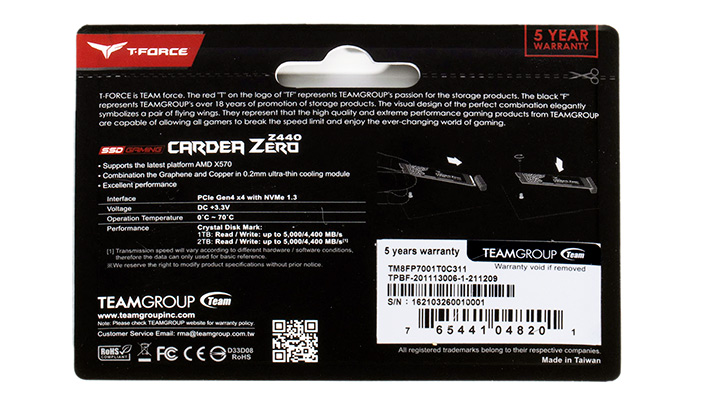TEAMGROUP T-Force Cardea Zero Z440 PCIe Gen 4.0 SSD Review
T-Force Cardea Zero Z440 Testing Continued And Conclusions
The testing of the T-Force Cardea Zero Z440 M.2 NVMe SSD continues with HDTune Pro, CrystalDiskMark, and PCMark 10's System Disk benchmark.
EFD Software's HD Tune is described on the company's website as such: "HD Tune is a hard disk utility with many functions. It can be used to measure the drive's performance, scan for errors, check the health status (S.M.A.R.T.), securely erase all data and much more." The latest version of the benchmark added temperature statistics and improved support for SSDs, among a few other updates and fixes.

The Cardea Zero Z440 once again distanced itself from the Sabrent Rocket 4.0 in this test's average read and write speeds. When we get down to the access times we can start to see why. It's just a few thousandths of a second, but the Z440 had very slightly quicker read access times and much improved write access times compared to the Rocket. When it comes to thousands or even millions of write operations, every millisecond counts, and in this case, those milliseconds allowed the Cardea Zero Z440 to jump out to a sizable lead over its Sabrent rival.
Meanwhile, both of these drives have no problem speeding past the PCIe 3.0 Addlink S70 and WD Blue SN550 drives. Both of those drives incur enormous read speed penalties compared to the Phison-powered PCIe 4.0 drives, on the order of 3.5 to 4 times as long.

Cardea Zero Z440 Reads

Cardea Zero Z440 Writes
The read test had no surprises. It hits very close to its average from start to finish. The write test shows how the caching scheme of this drive works. The first 70% o the drive showed write speeds of approximately 2.2 GB per second, around 10% faster than the average. That tails off in a stairstep fashion first at the 700 GB mark where the average dips below 2 GB/sec, and then the last 70 GB or so is only around 1.4 GB per second. The Phison E16 controller supports both a DRAM cache and an SLC caching mode where writes go into a portion of the NAND at one bit per cell rather than three, and once that space runs out it's relegated to slower speeds.

The drives are sorted by read access times here, of which the Cardea Zero Z440 posted the absolute lowest access times across the board. It actually wins on both counts. The Sabrent Rocket 4.0 shows why it struggled in the read test, as its access time was more than three times as long as the Cardea Zero. Finding the right cells is just part of the read process, but every millisecond counts when reading gigabytes of data. The WD Blue SN550 just about matched the read and write access speeds, but its PCIe 3.0 bus and the NAND

This is the one test where the Cardea Zero Z440 struggled, but it wasn't by much. It only trails the Sabrent Rocket 4.0 in reads by around 5%, with a 10% difference in writes. These burst operations are short, quick operations, compared with the long read operations of the first graph.
CrystalDiskMark is a synthetic benchmark that tests both sequential and random small and mid-sized file transfers using incompressible data. It provides a quick look at best and worst case scenarios with regard to SSD performance, best case being larger sequential transfers and worse case being small, random transfers.


The sequential tests each produced a strong showing for the Cardea Zero. This drive once again was roughly on par with the Sabrent Rocket 4.0 in the write tests, and twice as fast as the PCIe 3.0 drives from Addlink and WD. The read tests were oddly slower on three of the four drives in the QD1 test, but that corrected itself once the queue depth was longer. Once again the PCIe 4.0 drives separated themselves from the drives running on the older PCIe spec.


As with the sequential tests, the random read and write tests benefitted greatly from a deeper queue from which to draw transactions. The problem is that most client loads, like for a gaming PC or an office machine, rarely push the queue depths. As a result, all four drives were about as fast as one another in a client load. Once we get into a longer queue, the Cardea Zero is much faster, but only about 1/3 as quick as the Sabrent Rocket PCIe 4.0 drive. While the two drives share a controller, there are other differences between the two, and that really holds it back in the QD32 test.
We like PCMark 10's new quick storage benchmark module for its real-world application measurement approach to testing. PCMark offers a trace-based measurement of system response times under various scripted workloads of traditional client / desktop system operation. Here, we used the Quick System Drive storage benchmark, which puts the drive through its paces in a scripted 20-minute run of several different disk-oriented tasks.



While the Cardea Zero Z440 was in second place across the board, it's also within close proximity to the Rocket 4.0. The same Phison E16 controller with similar results is not an earth-shattering surprise. This test once again relies on a low queue depth and mixes sequential and very small random reads, so the bandwidth figures are pretty low for all drives. The PCIe 4.0 drives are faster than the Addlink S70 in absolute terms, but it's not by a whole lot.
The question comes down to how much you want to spend for an SSD, particularly a boot drive. At about $199.99 there are certainly cheaper options, all the way down to the ~ $123 WD Blue SN550. However, this drive's performance far outclasses budget drives. On the high side in the 1 TB range, there's the $265+ Samsung 980 Pro. This drive certainly does not have the same throughput as Samsung's flagship SSD, but it doesn't have quite the same price, either. The Cardea Zero Z440 is the Baby Bear in the story of Goldilocks And The Three SSDs. It's not too pricey, nor is it too flashy, but with its great performance at a reasonable price point, we'd say it's juuuuust right. For that reason, TEAMGROUP's T-Force Cardea Zero Z440 is definitely HotHardware Recommended.

TEAMGROUP T-Force Cardea Zero Z440
|
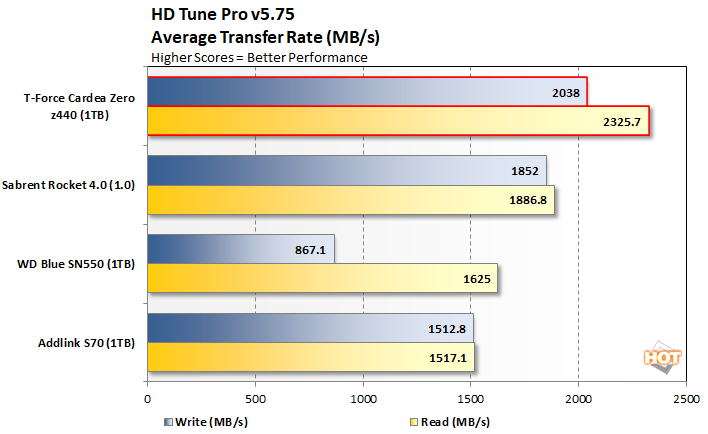
The Cardea Zero Z440 once again distanced itself from the Sabrent Rocket 4.0 in this test's average read and write speeds. When we get down to the access times we can start to see why. It's just a few thousandths of a second, but the Z440 had very slightly quicker read access times and much improved write access times compared to the Rocket. When it comes to thousands or even millions of write operations, every millisecond counts, and in this case, those milliseconds allowed the Cardea Zero Z440 to jump out to a sizable lead over its Sabrent rival.
Meanwhile, both of these drives have no problem speeding past the PCIe 3.0 Addlink S70 and WD Blue SN550 drives. Both of those drives incur enormous read speed penalties compared to the Phison-powered PCIe 4.0 drives, on the order of 3.5 to 4 times as long.
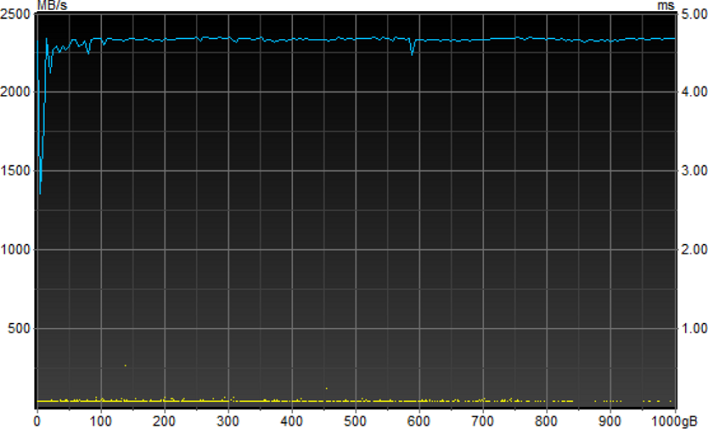
Cardea Zero Z440 Reads
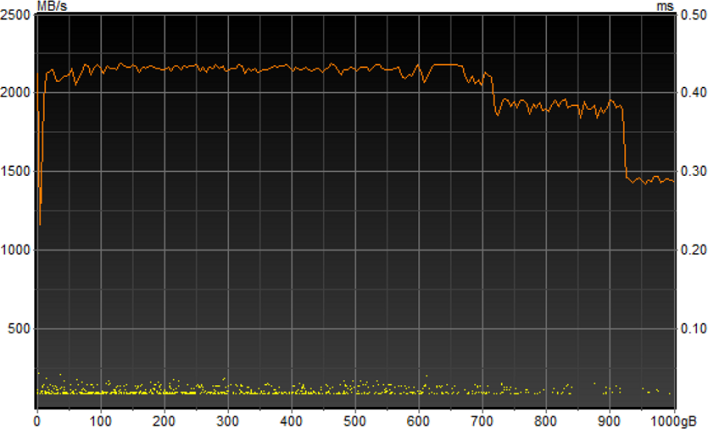
Cardea Zero Z440 Writes
The read test had no surprises. It hits very close to its average from start to finish. The write test shows how the caching scheme of this drive works. The first 70% o the drive showed write speeds of approximately 2.2 GB per second, around 10% faster than the average. That tails off in a stairstep fashion first at the 700 GB mark where the average dips below 2 GB/sec, and then the last 70 GB or so is only around 1.4 GB per second. The Phison E16 controller supports both a DRAM cache and an SLC caching mode where writes go into a portion of the NAND at one bit per cell rather than three, and once that space runs out it's relegated to slower speeds.
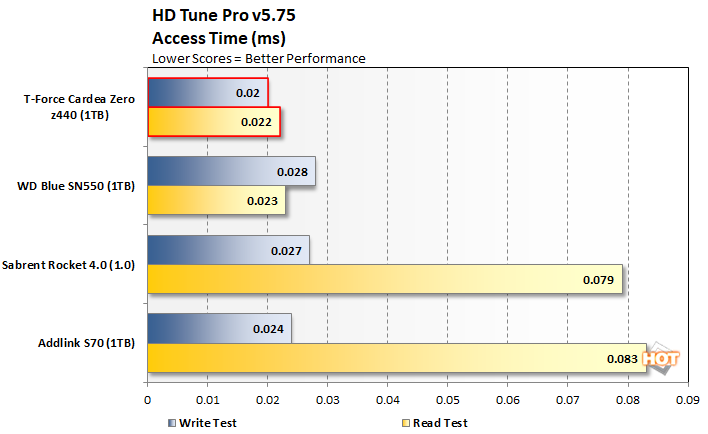
The drives are sorted by read access times here, of which the Cardea Zero Z440 posted the absolute lowest access times across the board. It actually wins on both counts. The Sabrent Rocket 4.0 shows why it struggled in the read test, as its access time was more than three times as long as the Cardea Zero. Finding the right cells is just part of the read process, but every millisecond counts when reading gigabytes of data. The WD Blue SN550 just about matched the read and write access speeds, but its PCIe 3.0 bus and the NAND
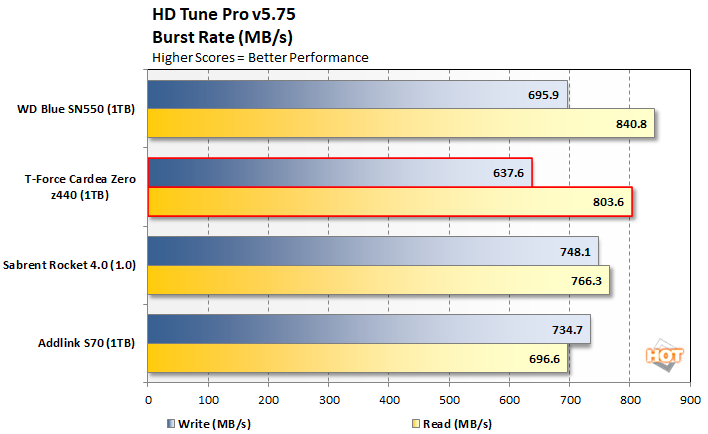
This is the one test where the Cardea Zero Z440 struggled, but it wasn't by much. It only trails the Sabrent Rocket 4.0 in reads by around 5%, with a 10% difference in writes. These burst operations are short, quick operations, compared with the long read operations of the first graph.
|
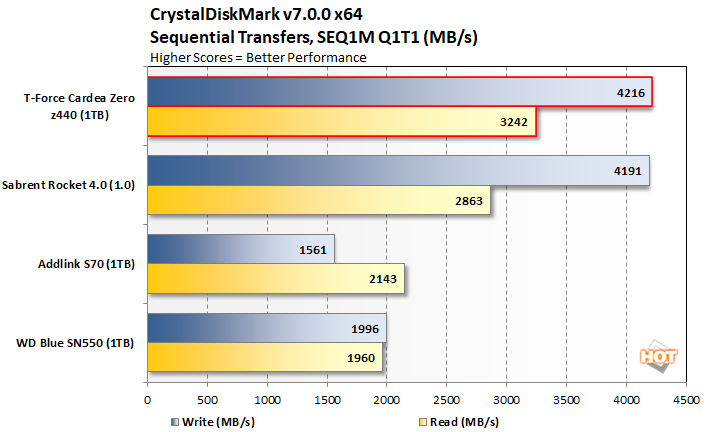
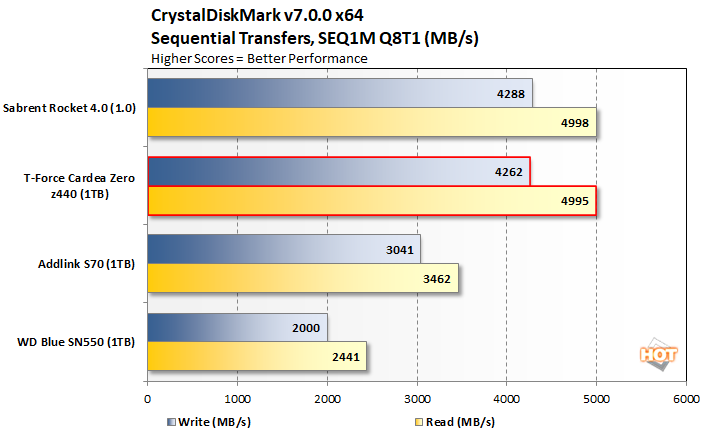
The sequential tests each produced a strong showing for the Cardea Zero. This drive once again was roughly on par with the Sabrent Rocket 4.0 in the write tests, and twice as fast as the PCIe 3.0 drives from Addlink and WD. The read tests were oddly slower on three of the four drives in the QD1 test, but that corrected itself once the queue depth was longer. Once again the PCIe 4.0 drives separated themselves from the drives running on the older PCIe spec.
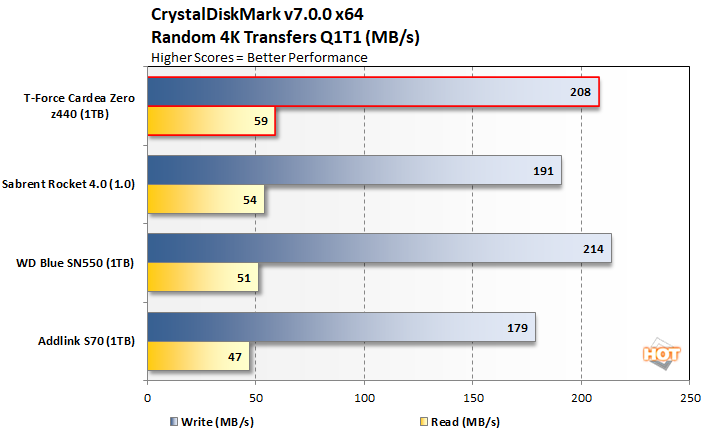
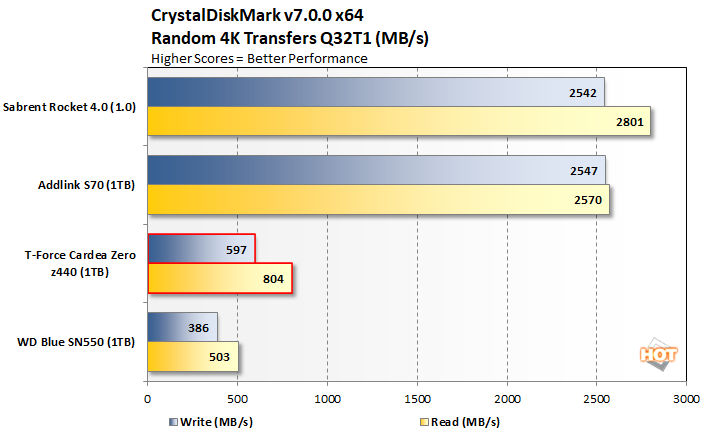
As with the sequential tests, the random read and write tests benefitted greatly from a deeper queue from which to draw transactions. The problem is that most client loads, like for a gaming PC or an office machine, rarely push the queue depths. As a result, all four drives were about as fast as one another in a client load. Once we get into a longer queue, the Cardea Zero is much faster, but only about 1/3 as quick as the Sabrent Rocket PCIe 4.0 drive. While the two drives share a controller, there are other differences between the two, and that really holds it back in the QD32 test.
|
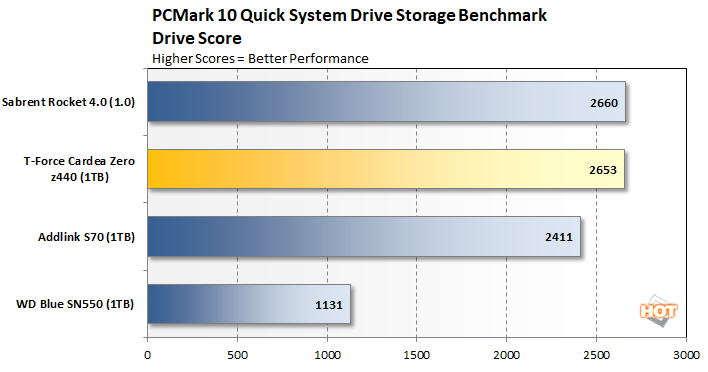
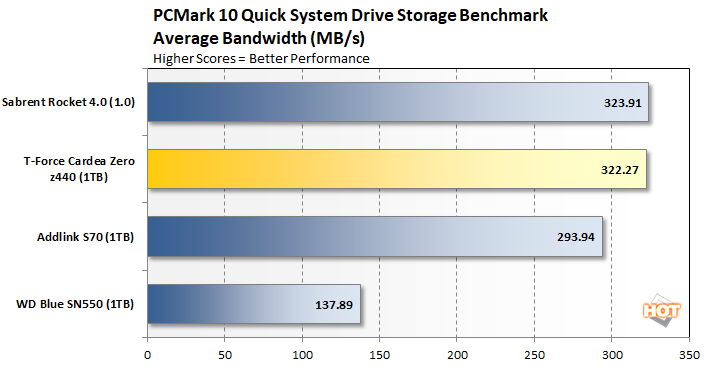
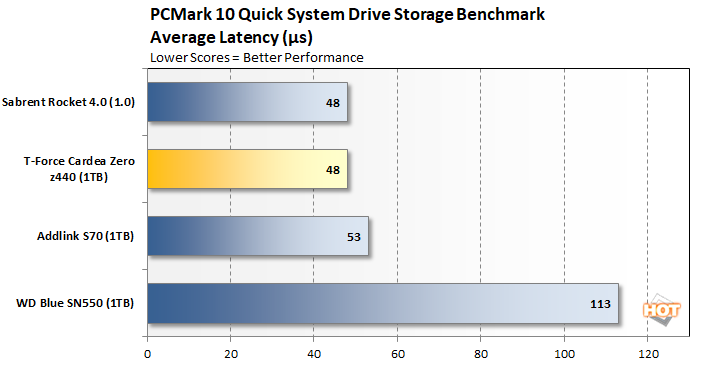
T-Force Cardea Zero Z440 Review Summary and Verdict
The Cardea Zero Z440 is a speedy PCIe 4.0 solid state drive. The Phison E16 controller and its DRAM cache are known quantities at this point, and the T-Force drive performed on par with similar drives, like the Sabrent Rocket 4.0. However, in a couple of tests it had some surprises up its sleeve. Solid wins in SANDRA 2021, ATTO Disk Benchmark's IO tests, and HD Tune prove that there is still some untapped performance to find in this first-gen PCIe 4 controller. The timing here is a little unfortunate, as updated drives with Phison's E18 controller and new flash are right around the corner, but those drives will likely carry a hefty premium.The question comes down to how much you want to spend for an SSD, particularly a boot drive. At about $199.99 there are certainly cheaper options, all the way down to the ~ $123 WD Blue SN550. However, this drive's performance far outclasses budget drives. On the high side in the 1 TB range, there's the $265+ Samsung 980 Pro. This drive certainly does not have the same throughput as Samsung's flagship SSD, but it doesn't have quite the same price, either. The Cardea Zero Z440 is the Baby Bear in the story of Goldilocks And The Three SSDs. It's not too pricey, nor is it too flashy, but with its great performance at a reasonable price point, we'd say it's juuuuust right. For that reason, TEAMGROUP's T-Force Cardea Zero Z440 is definitely HotHardware Recommended.

TEAMGROUP T-Force Cardea Zero Z440
 |
 |
||
|
|

